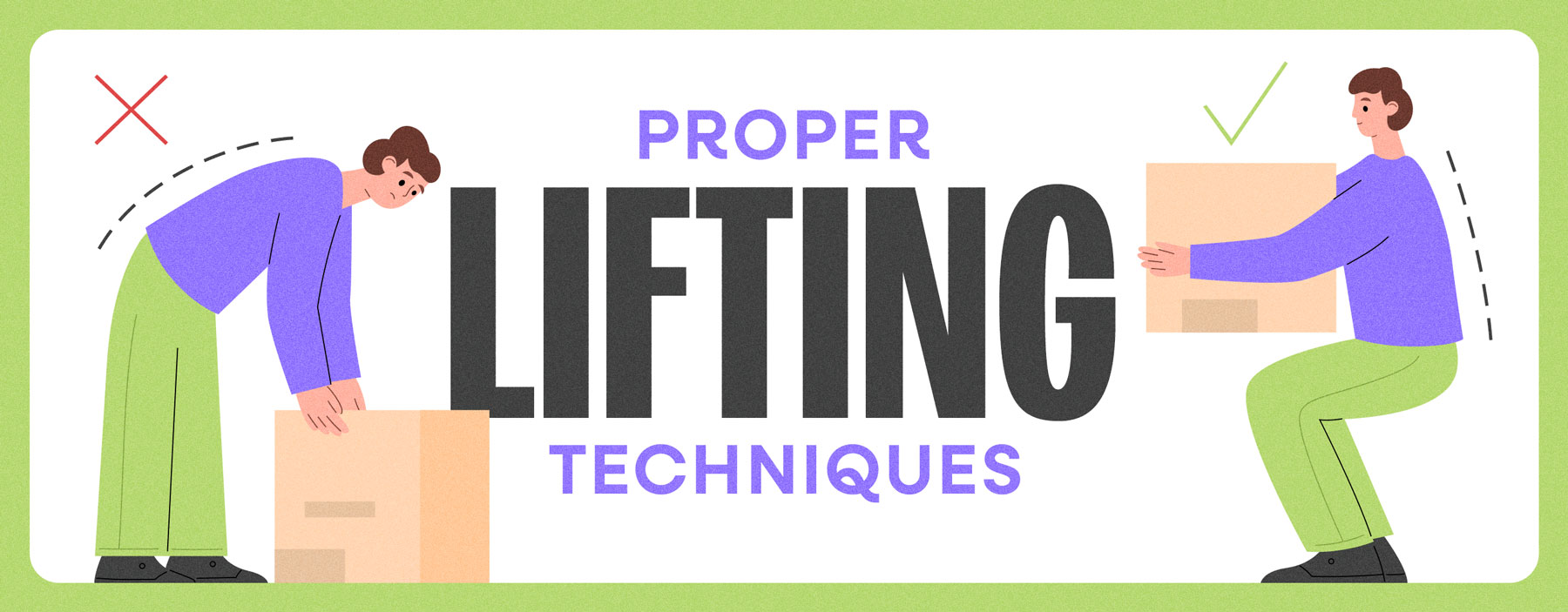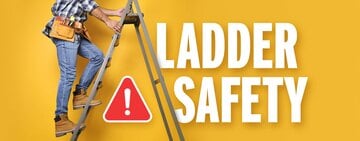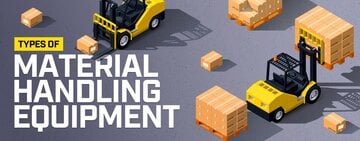
Lifting heavy objects is a common task in many industrial and commercial settings, and it is crucial to understand and implement proper lifting techniques to prevent injuries. In the United States, almost half of the reported back injuries each year occur in the workplace, with a significant number of these injuries related to lifting. While the Occupational Safety and Health Administration (OSHA) does not have specific ergonomic lifting standards, it does provide guidelines to encourage proper lifting habits. By following and promoting safe lifting guidelines, you can help reduce the likelihood of injuries and create a safer workplace for everyone involved.
Shop All Material Lifting EquipmentHow to Incorporate Safe Lifting Training

When adopting lifting training in your workplace, emphasize the health risks associated with improper lifting habits, introduce the concept of ergonomic lifting, and implement a proper injury reporting process. The key is to build a baseline understanding of what your employees need to do while they work, ensuring that everyone is on the same page about the hazards they face and techniques they need to follow.
Educate Your Staff on Health Risks
By promoting a culture of safety and wellness, you'll mitigate the risk of serious injuries or health conditions occurring in the workplace. Emphasize the following conditions and their warning signs to catch injuries when they happen and prevent them from getting worse.
- Muscle strains and ligament sprains: These injuries can be acute or chronic, causing discomfort and limiting mobility. Signs and symptoms may include pain that worsens with movement, muscle cramping, diminished flexibility, difficulty walking, pain when bending forward or sideways, and discomfort while standing.
- Herniated discs: This injury occurs when a disk slips out of place, usually in the lower back. Employees who lift large, heavy, or awkward objects are most prone to this type of injury. Warning signs include a sharp pain that radiates to other parts of the body and numbness or tingling in your extremities.
- Abdominal hernias: These hernias can be caused by heavy lifting or aggravated if an employee is working with an existing abdominal injury. Abdominal hernia warning signs include a burning or aching sensation or visible, palpable bulges in the abdomen.
Introduce Ergonomics
Incorporating ergonomic principles into your lifting practices reduces worker fatigue and minimizes strain on the body. Train your staff on what ergonomic lifting means and the best practices to adopt it in your workplace.
- Encourage employees to bend at the knees and hips rather than the waist when lifting. This technique distributes weight more evenly and reduces strain on the back muscles.
- Providing warehouse PPE, such as back braces or safety shoes, offers added support and protection for workers who are regularly engaged in lifting heavy objects.
- Implement job rotations and rest breaks into your work schedule. This allows employees to alternate between tasks and gives them time to recover.
- Invest in lifting aids such as pallet jacks, hand trucks, or hoists.
Develop a Proper Injury Reporting Process

When you work with heavy objects and machinery, injuries are inevitable. As an employer, it is your responsibility to provide an efficient and detailed reporting plan to quickly deal with any workplace injuries that might occur. Establish clear reporting procedures to streamline the process. Employees should know when an incident must be reported and what forms must be filled out.
Stress the importance of timely reporting to provide proper care and documentation. After an injury is reported, conduct a thorough investigation to understand what went wrong and how to prevent similar incidents. Take corrective actions based on the findings to ensure a safer work environment for all employees.
Ergonomic Lifting Techniques
The four key stages of proper lifting are preparation, lifting, carrying, and setting objects down. Outline and demonstrate each stage for your staff, providing a detailed walkthrough of what to do and why it is important. Verify that they have a solid understanding of these concepts and techniques before they start working, and hold regular refreshers to stay up-to-date and keep the information fresh in everyone's mind.
1. Preparation
Before lifting any object, take the time to assess several critical aspects of the job ahead of you to ensure a smooth operation. Although it might seem like a waste of time, fully analyzing the situation ahead of you will pay off in the long run.
- Plan your lift: Determine how much weight you can safely lift and ensure the load does not exceed that limit. Assess the object's size and consider whether it will be awkward to lift. Additionally, evaluate whether you will get a good grip on the object to maintain control throughout the lifting process.
- Plan your route: Ensure a clear and unobstructed path to your destination to avoid obstacles or safety hazards on the floor that could impede your movement. Consider your line of sight, especially if the object is large or if you are working in a confined space where your vision may be obstructed. Be mindful of the warehousing equipment you use and how it may impact your ability to see your surroundings.
- Warm-up: Focus on loosening up your back muscles and stretching out your hamstrings. Demonstrate common and effective stretches that are easy to do on the job and provide your employees ample time to perform them before they work.
2. Lifting
Most lifting-related injuries occur during the act of lifting an object. Though the specifics may vary based on the type of warehouse you work in and the objects you handle, following these fundamental steps provides a solid foundation for safe lifting practices.
- Positioning: Position yourself as close to the load as possible, maintaining a shoulder-width stance with your feet planted firmly on the ground.
- Footing: Keep one foot slightly ahead of the other to provide stability and balance.
- Bending: Bend at the hips and knees until you reach a squatting position, ensuring your head is held up straight and your shoulders are pushed back. Lift using the strength of your legs rather than straining your back.
- Stability: Engage your core muscles as you push against the ground to straighten your legs and lift the object.
Additionally, you should avoid the following actions as you lift heavy loads. Even these simple variations can cause awkward movements and put extra stress on your body.
- Never twist your torso while lifting.
- Refrain from lifting heavy items above shoulder level.
- Avoid carrying loads that obstruct your vision.
- Never hold your breath while lifting, moving, or setting down an object.
3. Carrying

Not only do ergonomic principles apply to lifting an object, but they also apply while you carry it. In most cases, this is the longest phase of the lifting process. A stable, steady base is imperative to carrying large loads successfully, helping you get to where you want to go without trouble.
- Hold loads as close to your body as possible: This reduces the strain on your muscles and helps maintain balance. Additionally, keeping the load at waist level can further minimize the chance of injury by promoting a more natural and comfortable posture.
- Maintain alignment between your shoulders and hips: Avoid sudden movements, which can strain your back and lead to injury. When changing direction, use your feet to pivot and lead with your hips to maintain stability.
- Take smaller steps: Large steps can throw off your balance. By taking smaller steps, you'll maintain better control of the object.
- Ensure you have a secure grip: Grab the object with your full hand and all your fingers until you set it down. This will help prevent the object from slipping or falling out of your grasp.
4. Setting Objects Down
In most cases, setting an object down can be as risky as picking it up. Many of the same principles apply, with slight variations depending on the task in front of you.
- Keep the load close to your body: Maintain a straight back and square shoulders, keeping the load close to your body for maximum control.
- Squat down while bending at the knees and hips: This will distribute weight evenly and reduce back strain.
- Tighten your core muscles: Doing this as you lower yourself provides added support and stability.
- Kneel on one knee: If you need to kneel while placing an object down, go down to one knee to maintain balance and control.
Back to Top
By implementing these training strategies and promoting a culture of safety in your workplace, you can help prevent workplace injuries and create a more secure environment for your employees. Remember, prioritizing safe lifting practices is not only a moral obligation to protect the well-being of your workforce, it’s a legal responsibility to comply with local safety laws.





